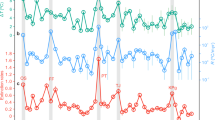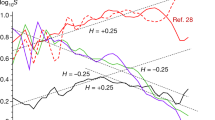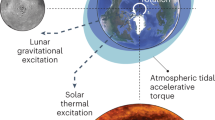Abstract
Raup and Sepkoski1 have recently reported evidence fora 26-Myr periodicity in the occurrence of mass extinctions based on a study of marine fossils. The data baseline of 250 Myr suggests events of variable amplitude, with some of the strongest peaks associated with boundaries between major geological periods which have been defined by previous palaeontological studies. In a more limited quantitative study, Fischer and Arthur2 earlier cited evidence for a 32-Myr period of major extinction events. Hatfield and Camp3 were among the first to suggest that mass extinctions might be correlated with periodic galactic phenomena, noting intervals of 80–90 Myr between major mass extinctions with an exceptionally strong mass extinction every 225–275 Myr. Here we point out a possible correlation between the 26-Myr extinction period and the Sun's oscillation about the galactic plane.
This is a preview of subscription content, access via your institution
Access options
Subscribe to this journal
Receive 51 print issues and online access
$199.00 per year
only $3.90 per issue
Buy this article
- Purchase on Springer Link
- Instant access to full article PDF
Prices may be subject to local taxes which are calculated during checkout
Similar content being viewed by others
References
Raup, D. M. & Sepkoski, J. J. Jr Proc. natn. Acad. Sci U.S.A 81, 801–805 (1984).
Fischer, A. G. & Arthur, M. A. Soc. Econ. Paleont. Miner. Spec. Publ. 25, 19–50 (1977).
Hatfield, C. B. & Camp, M. J. Bull. geol. Soc. Am. 81, 911–914 (1970).
Oort, J. H. Bull. Astr. Inst. Neth. 15, 45 (1960).
Oort, J. H. in Stars and Stellar Systems Vol. 5 (University of Chicago Press, Chicago, 1965).
Mihalas, D. & Routly, P. M. Galactic Astronomy, 221 (Freeman, San Francisco, 1968).
Bahcall, J. N. Astrophys. J. 276, 169 (1984).
Trumpler, R. J. & Weaver, H. F. Statistical Astronomy (Dover, New York, 1962).
Allen, C. W. Astrophysical Quantities, 283 (Athlone, London, 1973).
Pollack, J. B., Toon, O. B., Ackerman, T. P. & McKay, C. P. Science 219, 287–289 (1983).
Kauffmann, E.-G. in Proc. Conf. on Large Body Impacts and Terrestrial Evolution, 23 (Lunar and Planetary Institute, Snowbird, Utah, 1981).
Brown, R. L. & Gould, R. J. Phys. Rev. D1, 2252–2256 (1970).
Nousek, J. A., Fried, P. M., Sanders, W. T. & Krausharr, W. L. Astrophys. J. 258, 83–95 (1982).
Watson, M. G., Willingale, R., Grindlay, J. E. & Hertz, P. Astrophys. J. 250, 142–154 (1981).
Damon, P. E., Lerman, J. C. & Long, A. A. Rev. Earth planet. Sci. 6, 457–494 (1978).
Eddy, J. A. Science 192, 1189–1202 (1976).
Author information
Authors and Affiliations
Rights and permissions
About this article
Cite this article
Schwartz, R., James, P. Periodic mass extinctions and the Sun's oscillation about the galactic plane. Nature 308, 712–713 (1984). https://doi.org/10.1038/308712a0
Received:
Accepted:
Issue Date:
DOI: https://doi.org/10.1038/308712a0
This article is cited by
Comments
By submitting a comment you agree to abide by our Terms and Community Guidelines. If you find something abusive or that does not comply with our terms or guidelines please flag it as inappropriate.



